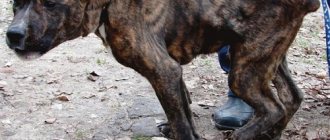We are accustomed to considering intestinal upset in dogs to be an ordinary phenomenon that does not pose any particular danger, so many owners are accustomed to not paying much attention to it. However, if your pet has constipation or diarrhea, this condition should under no circumstances be ignored, as this indicates a malfunction in the animal’s body that needs to be addressed urgently. Otherwise, intestinal disorder can lead to the development of serious complications, the treatment of which takes a lot of effort and time.
To begin timely treatment of the disease, it is necessary to identify the symptoms of stomach upset in a dog in time. Often this pathological condition is observed due to improper nutrition of the animal or the course of diseases dangerous to health. So, what are the symptoms of the disease in animals, and how is intestinal disorder treated?
Upset dog stomach - signs of inflammation
Before treating stomach and intestinal disorders in a pet, it is necessary to correctly identify the disease. Of course, the first symptom of its onset is considered to be diarrhea in the animal, which can be seen with the naked eye. However, the symptoms of this pathology are expressed not only in changes in the quality of stool. You can also detect an intestinal disorder in a dog by noticing the following symptoms of the disease:
- bloating;
- high body temperature;
- frequent refusals to eat;
- the dog does not go to the toilet for more than 3 days;
- frequent gag reflexes, in which only liquid and thick saliva are released.
If your dog has frequent stomach upsets, it is imperative to find out the cause of this phenomenon before starting treatment.
Classification of gastritis in dogs (types and types)
First of all, veterinarians divide the forms of gastritis into acute and chronic . The first type is characterized by severe symptoms, rapid progression and development; as a rule, it is treated simply because it is easily detected.
Chronic gastritis is a long-term, slowly developing disease that rarely makes itself felt. Its symptoms are vague, atypical, difficult to treat and often lead to serious complications.
Diseases are also divided according to the composition of the acidic environment, pathogens and general origin.
Dog stomach upset and its main causes
Doctors divide all the reasons why the disease may develop into 3 large groups. This:
- infectious;
- non-contagious;
- invasive.
Let's look at each of them in more detail. Non-communicable causes:
- The main one is long-term stress in the animal. If the owner and the pet moved to a new place of residence, if he is away from the dog for a long time, and other reasons can lead to a deterioration in the immune system. And this is a good chance for bacteria living in the body or entering it along with food to begin their active reproduction in a certain organ. It is not uncommon for a dog to experience frequent stomach upset, which causes a serious deterioration in the pet’s health.
- Hypothermia or overheating of the body can also cause an upset stomach in a dog. This is due to the fact that bacteria in the body begin to actively multiply when exposed to a certain temperature. Unfortunately, this cannot be avoided, since some types of bacteria live in the body, which is considered normal.
- A change in food is also considered the main cause of inflammation of the gastrointestinal tract. It is known that dogs produce certain enzymes in response to a specific type of food. If the owner stops giving the pet food to which the body is accustomed, this can provoke the development of inflammation, since the enzymes necessary for health will not be secreted by the animal’s body, believing that they will enter it from the outside.
- If dog food is not produced according to the rules, this makes the product unsuitable for animal nutrition, since, simply put, it is of poor quality. Inflammation occurs due to the fact that the food has undergone bacterial contamination - if the dog eats it, he will need urgent treatment.
- Inflammations of non-contagious etiology, in which there is no increase in temperature. It is known that any inflammation increases the temperature of any living creature. But there are some types of inflammatory diseases that occur without this symptom. However, if treatment is not provided to the dog on time, his body may not cope - and then a more serious and dangerous form of the disease will develop.
- Taking antibiotics also often causes intestinal upset. For example, if a pet underwent complex therapy to treat pneumonia, and the course of treatment lasted long enough, the drug suppressed normal intestinal activity, which caused inflammation. After 3 days, the microflora will be restored and the functioning of the pet’s digestive organs will return to normal.
Non-contagious causes are considered the most common in the development of intestinal inflammation, so they should be given more attention.
Several microorganisms are known to live in the intestines. There they multiply and secrete waste products that are toxic to the dog’s body.
Attention! The main difference between the infectious cause of inflammation is an increase in temperature soon after the development of the disease. Its increase indicates that the dog’s body is trying to independently fight bacteria by burning them.
Most often, an infection in the intestines is caused by salmonella - as the disease develops, the owner will immediately notice that something is wrong with the pet’s health, as it will have many symptoms of inflammation.
If the symptoms of an upset stomach in a dog make it clear that parasites have multiplied in the animal’s body, they cannot always be immediately noticed in the fecal matter, which is what owners often try to do in order to independently identify the cause of this ailment. Moreover, specialists in the laboratory are not always able to detect the parasite and their eggs.
In some species of helminths it is often possible to detect a period of sexual lability. What does it mean? This means that the parasite will not release eggs into the environment at first. Therefore, laboratory assistants will give a conclusion that there are no eggs in the dog’s digestive organs. However, this does not mean that there are no helminths in the intestines - they will still make themselves felt a little later. Therefore, for the health of your pet, it is important to carry out regular deworming, which will allow you to destroy parasites in a timely manner. However, in order to achieve the desired result, it is recommended to choose only complex therapeutic agents.
Sometimes intestinal inflammation in dogs is caused by the activation of roundworms in the body. They usually live in the lumen of the intestines, and when a favorable moment occurs, they begin to actively reproduce. Roundworms are single-celled and flat microorganisms that can cause isosporosis. These include coccidia and lamblia.
Symptoms
Disturbances in the gastrointestinal tract in dogs are manifested by 2 main symptoms: diarrhea and vomiting.
Diarrhea can have several varieties:
- Acute dyspepsia. The dog has had loose stools for a couple of weeks. At this time, it is important not to miss the appearance of such secondary symptoms as fever and lethargy in your pet. If they appear, then we can safely say that disturbances in the gastrointestinal tract were caused by poor-quality food. Coping with acute dyspepsia is not difficult. It is important here to prevent acute diarrhea from becoming chronic.
- Subacute dyspepsia. This type of diarrhea is most often detected in puppies that have not received timely vaccinations. It is provoked by various infections. In addition, subacute dyspepsia can be caused by chemical poisoning. With this form of diarrhea, you should definitely seek help from a veterinarian.
- Chronic diarrhea. This type of dyspepsia lasts more than 2 weeks and is a symptom of some chronic disease: pancreatitis, gastritis, salmonellosis, dysbacteriosis and others.
How is the treatment carried out?
How to treat intestinal inflammation in dogs? Treatment for indigestion in dogs is done through several medications. This:
- Antibiotics
. These medications are considered the very first medications that animals need to take when inflammation develops. For example, a doctor may prescribe Levomycetin for a pet. The dog should be given it 2 times a day - a large dog should be given ¼ tablet, and a small dog 1/6. The course of antibiotics should be at least 6 days. - Nitrofurans
. These drugs are rightfully considered effective and quite harmless for the health of the animal. The most famous medicine is Furazolidone. If your dog is bothered by frequent intestinal problems, the medication will help normalize the intestinal microflora, as well as destroy protozoa, fungi and helminths. The dose of the medicine should be prescribed by a doctor, based on the cause of the disease and the general health of the animal. - Anthelmintics
. How to treat intestinal disorder in a dog? If the inflammation is caused by helminths, the pet needs to take this group of drugs, for example, Procox. This is a special oral suspension that fights all types of helminths and also restores the normal functioning of the digestive organs.
How to treat frequent intestinal disorders if you don’t have a veterinary first aid kit at hand? In this case, you can give the animal sulfademitoxin. It helps to cope well with the symptoms of inflammation of the digestive organs, as well as normalize their functioning. The dose of the drug is 20-25 mg per kilogram of animal weight. You should take the medicine for 10 days. If positive dynamics of therapy are not observed after 3 days, you need to stop taking sulfademitoxin and visit a doctor to prescribe a more effective and efficient drug.
If the inflammation becomes chronic, the symptoms of the disease will subside or be mild. You should not be happy that your pet has fully recovered, because the longer the dog is left without treatment, the greater the likelihood of complications developing. However, it is prohibited to prescribe treatment for a dog on your own, since this can only be done by the attending physician, who will conduct a full examination and identify the true cause of the development of the disease.
general information
The stomach of an animal is a bag-like structure necessary for the primary processing of food entering it. In dogs and cats, chewed and swallowed food remains in the organ cavity for no more than a couple of hours. This is due to the high speed of their digestion and the short length of the digestive tract. So what is pylorospasm in cats and dogs? To understand this, you need to remember the basics of anatomy and physiology.
From the esophagus to the stomach, crushed food flows freely, by gravity. On the inner surface of the organ there are a series of “folds” called gastric folds. They are based on striated muscles, so these folds can actively contract, helping in the grinding and digestion of feed masses. The inner covering of the organ secretes acids and enzymes for the primary digestion of food eaten. When the process is complete, the partially digested food leaves the stomach through a special organ called the pyloric sphincter. Abbreviated as pylorus. The “destination” is the duodenum, but when describing pylorospasam, this stage no longer has much significance.
Causes
Stool disorder occurs due to many factors. Not all reasons are related to health problems: sometimes it is enough to optimize the diet, and the problem disappears.
Diarrhea in small dogs is caused by many factors:
- binge eating,
- viral infection,
- food poisoning,
- intestinal obstruction,
- development of enteritis,
- inflammatory processes of the intestinal mucosa,
- hemorrhagic enteritis of unknown etiology,
- benign and malignant tumors,
- disruption of the pancreas,
- transition of a pet from natural food to dry food and vice versa.
Look at the description of the Dachshund dog breed and learn about the character of the dog with a long body and short legs.
General directions of therapy and effective methods of treating ringworm in small breed dogs are collected in this article.
There are other causes of diarrhea in dogs:
- polyps in the rectal area,
- the dog suffers from irritable bowel syndrome,
- acute stress,
- ulcerative colitis,
- worms in the intestines,
- eating out of order
- negative reaction to a new product or food allergy.
In addition to the consistency of your dog’s stool, it is important to pay attention to the smell. In any case, feces have a specific smell, but with helminthic infestations, malignant tumors, enteritis, or severe damage to the pancreas, a distinct cadaverous, putrid or sour odor appears. Only by contacting a veterinary clinic can the exact cause of changes in stool in four-legged pets be established.










